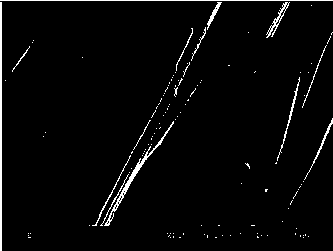Method for preparing sodium niobate fiber by combining hydrothermal method and later thermal treatment process
A technology of sodium niobate and hydrothermal method, which is applied in the field of preparation of one-dimensional sodium niobate materials, can solve the problems of the preparation method of sodium niobate fibers, etc., and achieve the effects of good dispersion, perfect growth and development, and obvious fiber characteristics
- Summary
- Abstract
- Description
- Claims
- Application Information
AI Technical Summary
Problems solved by technology
Method used
Image
Examples
Embodiment 1
[0020] 1. Weigh 24g of sodium hydroxide and 0.2g of niobium oxide, add the two materials into a beaker filled with 60ml of deionized water, and stir magnetically at 60°C for 2h until the mixed solution becomes a white slurry without obvious solid particle precipitation.
[0021] 2. Pour the white slurry obtained after stirring evenly into a PTFE-lined hydrothermal reaction kettle with a volume of 100ml. At the same time, add a magnetic stirrer in the reaction kettle, seal it and put it into the oil with magnetic stirring function React in a bath at 160°C for 6 hours. During the reaction, magnetic stirring is always maintained at a rate of 60 r / min.
[0022] 3. After the reaction, the obtained white precipitate was filtered, washed repeatedly with deionized water, and dried at a constant temperature of 110° C. for 12 hours in a blast drying oven.
[0023] 4. Put the obtained initial product into a muffle furnace for heating at 400° C. for 2 hours, then cool down to room tempera...
Embodiment 2
[0025] 1. Weigh 48g of sodium hydroxide and 0.4g of niobium oxide, add the two materials into a beaker filled with 120ml of deionized water, and stir magnetically at 60°C for 2 hours until the mixed solution becomes a white slurry without obvious solid particle precipitation.
[0026] 2. Pour the white slurry obtained after stirring evenly into a PTFE-lined hydrothermal reaction kettle with a volume of 200ml. At the same time, add a magnetic stirrer in the reaction kettle, seal it and put it into the oil with magnetic stirring function React in a bath at 160°C for 6 hours. During the reaction, magnetic stirring is always maintained at a stirring rate of 120 r / min.
[0027] 3. After the reaction, the obtained white precipitate was filtered, washed repeatedly with deionized water, and dried at a constant temperature of 110° C. for 12 hours in a blast drying oven.
[0028] 4. Put the obtained initial product into a muffle furnace and heat it at 450°C for 2 hours, then cool to roo...
Embodiment 3
[0030] 1. Weigh 24g of sodium hydroxide and 0.2g of niobium oxide, add the two materials into a beaker filled with 60ml of deionized water, and stir magnetically at 60°C for 2h until the mixed solution becomes a white slurry without obvious solid particle precipitation.
[0031] 2. Pour the white slurry obtained after uniform stirring into a 100ml polytetrafluoroethylene-lined hydrothermal reaction kettle, seal it and put it in an oil bath at 160°C for 6 hours, without stirring during the reaction.
[0032] 3. After the reaction, the obtained white precipitate was filtered, washed repeatedly with deionized water, and dried at a constant temperature of 110° C. for 12 hours in a blast drying oven.
[0033] 4. Put the obtained initial product into a horse-boiling furnace and heat it at 650°C for 2 hours, then cool to room temperature with the furnace, and the final product is fibrous sodium niobate. Weigh the obtained sodium niobate fiber, and its weight is about 0.05g , the scan...
PUM
| Property | Measurement | Unit |
|---|---|---|
| length | aaaaa | aaaaa |
| diameter | aaaaa | aaaaa |
Abstract
Description
Claims
Application Information
 Login to View More
Login to View More - R&D
- Intellectual Property
- Life Sciences
- Materials
- Tech Scout
- Unparalleled Data Quality
- Higher Quality Content
- 60% Fewer Hallucinations
Browse by: Latest US Patents, China's latest patents, Technical Efficacy Thesaurus, Application Domain, Technology Topic, Popular Technical Reports.
© 2025 PatSnap. All rights reserved.Legal|Privacy policy|Modern Slavery Act Transparency Statement|Sitemap|About US| Contact US: help@patsnap.com



